How To Make A Fire Without Matches
How to Make a Fire
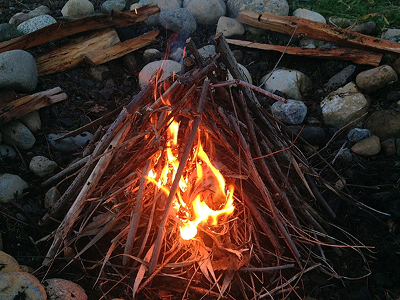
By Heather Swift
Knowing how to make a fire is a quintessential survival skill. It provides invaluable heat and calorie-free and can enable water purification, cook nutrient, warm a survival shelter, and repel insects and animals. Fire can even salve a life by preventing or aiding in recovery from hypothermia.
Moisture climates, such every bit the Pacific Northwest coast, provide challenging environments for fire skills. Mastering how to make a burn in moisture climates gives y'all valuable tools to be able create burn anywhere. In all areas, particularly dry environments, information technology is essential to also acquire and follow wildfire prevention.
There are a number of keys for success in learning how to brand a fire including site option, preparation, materials, design, mental attitude, rubber & ethics, and of form practice!
Before starting a fire, make sure y'all are in an area where information technology is condom and ethical to practise so—pay attention to burn bans or loftier fire gamble that result from dry weather or strong winds. Ensure that fires are permitted and follow safe guidelines which are described later in this article.
How to Brand a Fire - Preparing the Area:
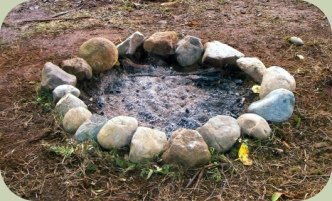
First yous demand to select a spot and set up the area for your fire. At sites with prepared firepits make sure y'all choose ane that is downwind and at least fifteen feet from your tent and gear (so that embers don't float onto your tent or equipment, burning holes in them or worse, communicable them on burn down).
The spot should be void of grass, plants or droppings and should have a band of rocks surrounding information technology. The surface area surrounding the fire band should also be free of debris. In drier areas, articulate a 10-foot diameter around the fire site. Remove any burnables close past. Avoid overhead tree limbs every bit well as cloak-and-dagger roots that could catch on fire.
In areas without pre-existing fire rings, dig a shallow pit and circle information technology with rocks. In these areas, fire safety is even more than crucial.
How to Make a Fire - Gathering Materials:
You will need a fire starter, tinder, small kindling, large kindling, and fuelwood. Each is described below:
Burn down Starters
You will need a method to light your fire. In a survival situation, make sure you accept something you reliably know how to use such equally a lighter or matches (waterproof ones help). If y'all are experienced, y'all tin can also use flint and steel, a magnifying glass, or a friction burn down kit such as a bow drill or hand drill. You can read our evaluation of more fire starters.
Tinder
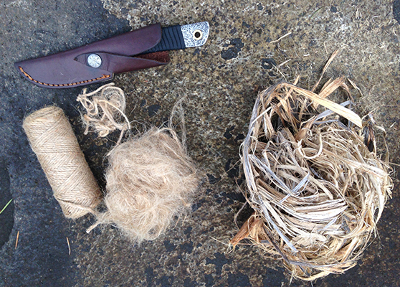
Tinder is highly-flammable material. It needs to catch fire quickly and hold the flame long enough to allow other materials to kickoff burning. It's a good idea to go on a protected dry out tinder bundle in your survival kit or backpack.
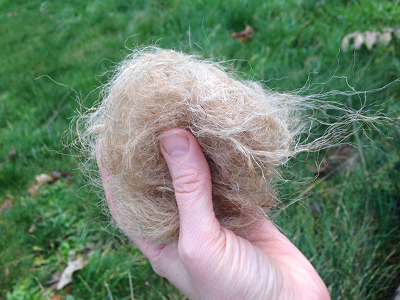
Homemade Tinder – This can be made from pieces of jute twine. Simply unravel short pieces and fluff them up to make an excellent tinder resource (pictured higher up). Yous can also use dryer lint, cotton wool assurance that had been soaked in warmed petroleum jelly, or very fine wood shavings.
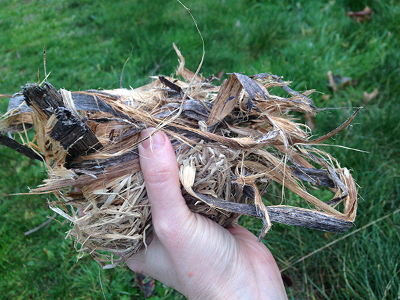
Wild-Harvested Tinder - You tin use dry expressionless plant material; inner bark fibers; shredded dry out leaves, grasses and moss; and/or very fine forest shavings. You can add together conifer pitch (dried sap resin), and/or the seed fluff of cattails or fireweed, to extend your tinder bundle. If you find a downed blackness cottonwood or western reddish cedar tree or a tree losing its bark, the inner bawl can make excellent tinder. Sometimes you tin can just peel information technology right off or you can scrape off the fibers of the inner bark using a pocketknife or sharp stone, and so fluff it upwardly. A tinder bundle made from the inner bark of cedar is pictured above.
Kindling
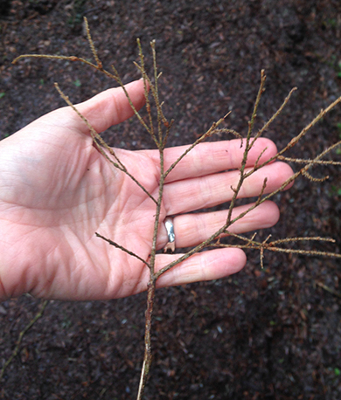
Small Kindling (also known as "thin and whispies", 1-2 millimeters thick) – When tinder ignites, information technology will demand to catch onto something larger but still minor. Very thin, dry brittle twigs will help the flame grow. The lower branches of evergreen conifer copse oft take attached expressionless or dying branches that are very sparse and breakable (but nearly 1-2 millimeters thick). Test them past breaking some off. If they snap, they will fire well. If they bend, they are too light-green to take hold of hands. Some species of hardwoods besides take adept pocket-size kindling. Collect a good pile of these.
FREE Mini Survival Guide: "Thriving in the Outdoors"
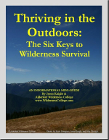
In this 9-page guide, you'll discover keys to starting a fire, edifice a shelter, purifying h2o, finding food... and many more than life-saving skills.
Get your FREE copy at present past signing up to our list. Discover more.
Larger Kindling (branches 1/8-one/ii" bore and well-nigh a foot long) – Pocket-sized kindling catches burn down well merely will burn out quickly. You also demand thicker kindling. In dry areas you may be able to collect from the ground. In the moisture Northwest, you may need to pull sticks from dead or dying trees or cutting minor pieces from dry out logs using a small hatchet or fixed blade survival pocketknife. Small pieces of cardboard and larger woods shavings can make good kindling. Igniting easily, kindling also sustains plenty estrus and flame to calorie-free the fuel materials.
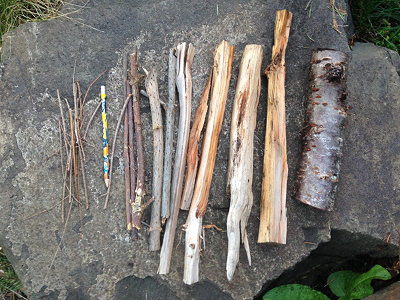
Fuelwood (ane"-5" diameter) - Fuelwood will sustain the fire and keep it going. Smaller wood volition burn chop-chop. Larger fuelwood will feed it. Once more, wood that is anile, dry and brittle will burn all-time. Green wood will take a long time to catch fire and will smoke more. Hardwoods have longer to catch, only volition burn longer than softer woods. Softwoods are improve at starting fires and hardwoods are better at sustaining fires. To keep a fire going overnight, y'all will need a big amount of fuelwood on hand. It is besides a adept idea to have extra tinder and kindling in case your burn down goes out.
Conifer Softwoods: Conifers (cone-begetting evergreens) accept softer woods. They will burn quicker and hotter and volition pop and crepitation more equally they have more than resin. Examples of conifer softwoods include Douglas Fir, Pines, Cedars, Hemlocks, and Spruces.
Hardwoods: Hardwoods accept longer to start burning but burn longer. Examples of hardwoods include Oaks, Maples, Madrone, Ashes, Beeches, Hickory, and Blackness Locust.
Even in wet conditions, y'all can still detect materials dry plenty for called-for. Materials from live trees and plants don't burn well and impairment the landscape. The best materials will exist establish on standing dead woods from snags (expressionless or dying trees, just non ones that are punky and decayed). Downed copse tin can have good dead branches that are off the potentially wet ground. Wood should exist breakable. Twigs and sticks should snap.
In wet conditions, protect your drier gathered materials from taking on more moisture from the wet ground and rain from above. This can be accomplished by placing materials within a jacket or plastic bag or between tarps or inside a shelter while y'all are preparing for the burn down.
How to Brand a Burn down - Design:
Collect a large pile of kindling and fuelwood and begin constructing your fire construction before you lot attempt to low-cal it or start a friction fire coal. It would exist extremely disappointing and potentially dangerous in a survival situation to beginning your burn down before your materials are ready. If in that location is more than i person, work as a team--1 person to collect and 1 to build the fire. You can also take turns tending the burn down once started.
In that location are several designs for fires such as the log cabin, lean-to, and the cantankerous. For survival fires, I like the fire tipi design. If congenital well, they catch quickly and provide a lot of heat and light. If the ground is wet, lay some kindling at the bottom of the burn pit to elevate your fire off the ground a chip. Outset making a small mound of thin and whispies in the middle of the burn down pit. Create a modest opening in the side of the sparse and whispy pile as a place for the tinder bundle one time lit. Overlay your small kindling into a tipi shape around the mound. Make sure the tipi structure feels strong and balanced to avoid tipping over from weight or wind. Starting time adding a few pieces of larger kindling and minor fuel around the tipi keeping the small opening accessible.
Now you tin can light your fire. If you lot are lighting past match or lighter, you tin can identify the tinder bundle in the opening and light it while blocking the current of air. If you are starting by friction burn down, be close to the tipi and place the lit tinder bundle into the tipi opening once the tinder packet is flaming.

Permit the flame abound and feed the fire with some air by blowing on it. Burn down needs air flow! Start building upward the tipi with more than kindling and fuel slowly, avoid placing materials right on acme of the tipi or calculation too much fabric too quickly—information technology may plummet or get smothered.
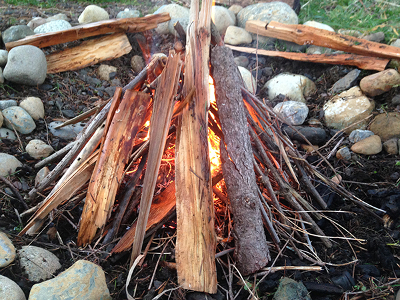
How to Brand a Fire - Tending Your Burn:
Fire needs disposed. Never leave a burn down unattended since information technology could very speedily spread or die out. After y'all have a good fire going, go on wood close only non as well shut. You can dry out wetter wood around the rim, but monitor advisedly so they don't grab fire prematurely. Add larger pieces of dry out wood every bit you go. If you lot are non alone, you can take turns disposed the fire.
How to Make a Burn down - Attitude:
This is rarely talked about but attitude tin make all the difference for determining success or failure. Making a burn can be challenging in stressful weather. Similar many wilderness survival skills, fire making can exist highly mental. Being grounded and relaxed with a clear mind will help you be successful. Challenging atmospheric condition tin humble even an experienced survival skilful. Notice means to warm your hands before starting since yous may be cold. Common cold hands lose dexterity and can lengthen the process. Practicing in different weather condition will help you stay at-home in the event of really needing burn for survival.
How to Make a Fire - Prophylactic:
Every year wildfires are started past campfires in inappropriate locations, embers carried by wind, or campfires not put out completely. Fire safety is even more than important than beingness able to start a fire. To extinguish a fire completely, let woods to burn down to ash completely. Douse it with water, dirt or sand (depending on if h2o is available) and drown all the embers, not just the cherry ones. Cascade water until all hissing sounds cease. Stir ashes and embers with a shovel or fire tending stick (just make sure information technology doesn't re-ignite). Scrape the sticks and logs to remove any embers. Stir until everything is cold to the touch on. Never coffin a fire. Information technology could go along smoldering and grab roots on burn down.
If the area has burn bans or high burn risks, choose alternative methods of heat and cooking. Still, never melt with a stove in your tent! Carbon monoxide poisoning is a leading cause of decease in the backcountry from stoves in tents.
Be highly conscientious when making fires in or effectually survival droppings shelters. Without proper venting, there is potential of smoke inhalation and debris shelters tin can catch on burn down!
Condom Tips:
-Place unused firewood upwind, away from the fire
-Go along a bucket of water and/or shovel nearby
-Roots can catch on fire underground. Don't build fire on areas where in that location are roots, particularly in dry out atmospheric condition. Even if your fire is out, information technology could nonetheless catch on burn surreptitious.
-Keep your fire to a manageable size
-Make sure children and pets are supervised
-Never leave your campfire unattended
-Never cutting live trees or branches from alive trees
-Don't burn down dangerous things! (droplets cans, pressurized containers, glass, aluminum cans)
-Put out fires thoroughly when leaving the site and pack out your waste material!
How to Make a Burn down - Exercise Tips:
-Get-go practice making a fire in a safe environment with like shooting fish in a barrel atmospheric condition.
Later on you lot master that, challenge yourself by:
-Making a fire using only one match.
-Making a fire in v minutes.
-Making a fire in wet conditions.
-Learn how to start a fire using a bow drill.
With all of these elements in heed, go out and practice! Remember to continue practicing, and to make sure to put safety first. When yous are done with your fire, ever exist sure to douse them with water and stir the water into the ash and dress-down to guarantee information technology is fully out.
Good luck and savor practicing how to make a fire!
Additional Resources on How to Brand a Fire:
Tips on How to Make a Fire at Wildwood Survival
Survival & Fire Making Classes at Alderleaf

Virtually the Author: Heather Swift is an experienced naturalist, teacher, and ethnobotanist. She teaches about plants at Alderleaf. Acquire more about Heather Swift.
Return from How to Brand a Burn down back to Wilderness Survival Articles
Noesis is Power - Grow Your Wilderness Skills! Get monthly updates on new wilderness skills articles, upcoming courses, and special opportunities. Join the free Alderleaf eNewsletter and as a bonus you'll get our mini survival guide:
Source: https://www.wildernesscollege.com/how-to-make-a-fire.html
Posted by: stoneyoutims.blogspot.com


0 Response to "How To Make A Fire Without Matches"
Post a Comment